
Shielfield Park
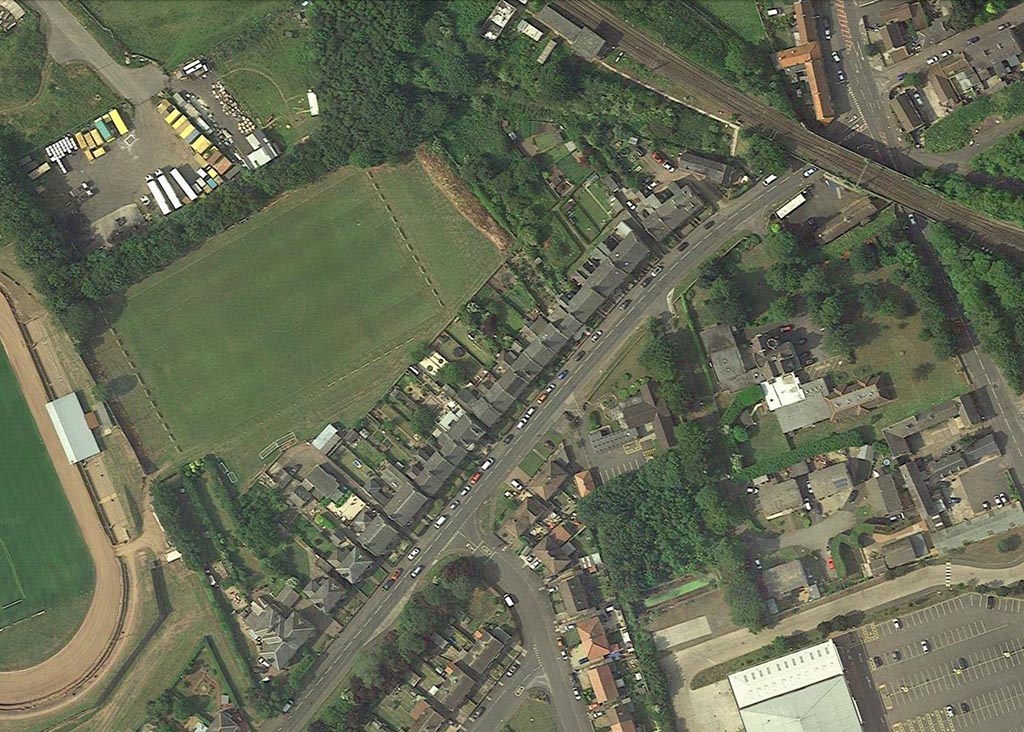

Google Earth aerial view of (Old) Shielfield Park and surrounding area.
Hover image to enlarge
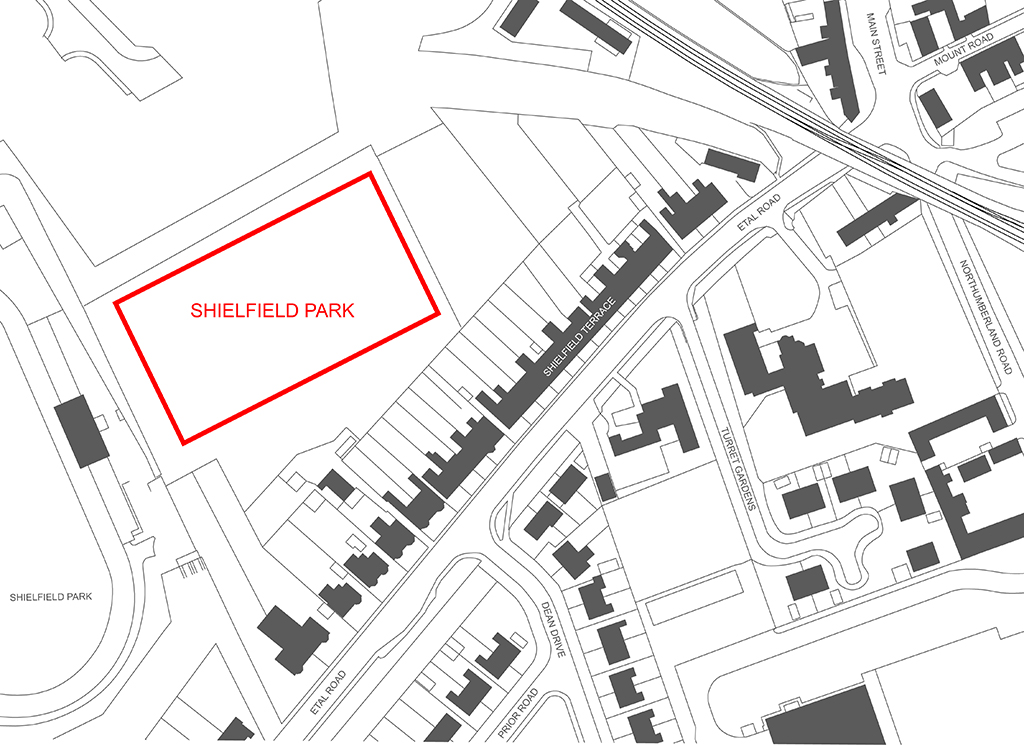

Overlay map of (Old) Shielfield Park and surrounding area.
Hover image to enlarge


A view down the Old Shielfield Park pitch. June 2014.
Hover image to enlarge
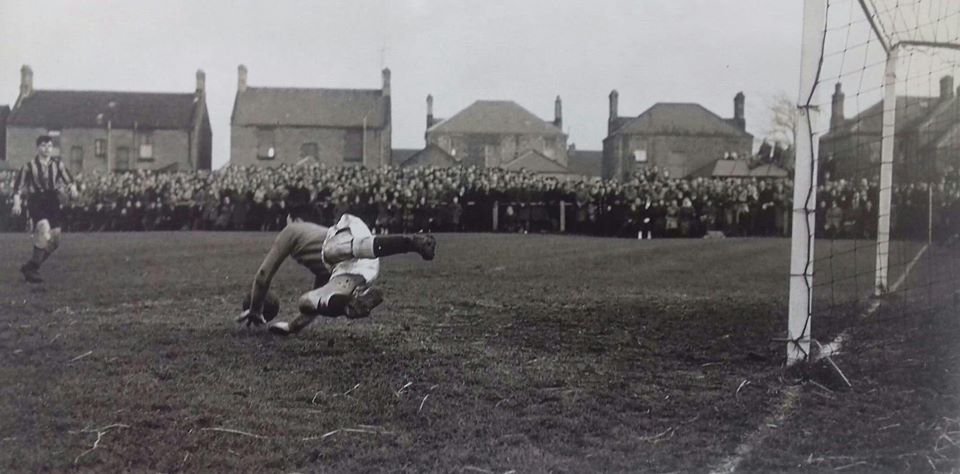
Hover image to enlarge

Match action at (Old) Shielfield Park.
24th January 1953, Scottish Cup 1st Round, Berwick Rangers 3-3 Dundee United. Attendance 3500
(Old) Shielfield Park
Tweedside Wanderers were the first tenants of “Mr Dods’ field beside the Etal Road” during the latter half of the 1889/90 season. William Shiel Dods was a local business man who organised a New Year’s Day competition to be played on his field and it became known as Shiel’s Field and later shortened to Shielfield.
In 1891, a row of terraced houses was built alongside the ground and, much to the annoyance of the General Post Office, the residents began using the address Shielfield Terrace rather than Etal Road.
Berwick Rangers first attempt to play at Shielfield in 1891/92 was knocked back with the formation of the Shielfield Athletic Football Club from the ashes of the Tweedside Wanderers and Seaside Rovers, who had ceased to exist. However, the following season the demise of Shielfield Athletic had left the ground vacant, and Rangers moved in quickly to make arrangements for the use of the ground.
The move was made in the hope of increasing local interest in the game with the provision of better facilities, especially against the weather. Ground improvements were carried out during the summer months with further levelling of the pitch at the railway end, allowing the playing area to be increased to 120 yards by 60 yards. A wooden fence was erected around the pitch to keep the spectators from the touchline and the club acquired their first set of goal nets in time for their opening match of the season.
There had been a good deal of talk about the inconvenience of Shielfield, owing to its distance from the town, affecting crowd numbers, but it was considered the best option available. More ground improvements were made for the start of the 1894/95 season, including the widening of the playing area to suit the requirements of the English FA Amateur Cup competition and during the following close season the railway end was levelled off.
At the start of the 1900/01 season, there were doubts as to whether Berwick Rangers would continue, the Club did not renew their interest in Shielfield and Tweedside Albion were quick to relocate there from the Meadow Field.
The involvement in organised Scottish football by Berwick Rangers in 1905/06 brought about the dissolution of the Tweedside Albion Football Club, who felt that they could not hope to attract support in the face of more Rangers success. A new club, Berwick Volunteer Artillery Football Club, was formed and took over the tenancy of Shielfield.
Berwick Rangers made Shielfield their home for a second time during season 1906/07. A rise in rental and financial constraints made it impossible for the Rangers to continue playing at the Union Park and the committee approached Mr. William Shiel Dods, who kindly agreed to place the now vacant ground at Shielfield at the disposal of the club at a very nominal rent. Work began immediately to bring the ground up to scratch, although the opening fixtures of the season were to take place on the Union Park.
Rangers remained at Shielfield for just two seasons. After a disappointing season, combined with poor attendances, calls were made by supporters for a return to Union Park, which was considered the best central field in the borough. The loss of the Union Park had not only been a disaster for Berwick Rangers, but also a blow to local football supporters in general. Negotiations took place with a view to leasing the Union Park for the 1908/09 season but, due to the limited timescale, it was agreed to take Shielfield for the same rent as before with the first few matches, at least, to be played there.
Football in the borough was slow to emerge from the shadows of the First World War. Spittal Hearts and the reformed Tweedside Albion began playing friendlies in the early months of 1919, but the future of Berwick Rangers still hung in the balance.
There was nothing was left of the old club. The lease on the Union Park had lapsed; the Pavilion, along with the fencing, had been sold for building materials for the sum of £18 and even the players’ shirts had been disposed of.
On the question of a playing field it was thought that there would not be much of a problem in securing the use of the Union Park from new owner Mr. John Robertson of the Mill Farm, Tweedmouth, at least until the start of the newly proposed housing scheme. However, Spittal Hearts, after a failed attempt to amalgamate with Tweedside Albion, had changed their name to Berwick United and were also in negotiations for the ground.
Both Rangers and United had ambitions of join the ESFA and SFA and playing in their associated competitions. No club was to be admitted to either association unless they had a private ground of their own and on this front Berwick United were at the fore – they had acquired the lease of the Union Park from under the noses of the Rangers. In response, Rangers moved quickly to secure the use of the old football field at Shielfield for the season. Their only real concern was the out-of-the-way location of the Shielfield ground and the consequent difficulty in getting even the most enthusiastic supporters to the top of Tweedmouth.
It was felt by many that a large part of the Rangers’ problem was that the town could only support one club and that they should amalgamate with Berwick United. If there was only one well managed team in the borough it should be as successful as the Rangers in seasons past when honours were won. The recently formed Scremerston Football Club was about to join the North Northumberland League for the 1920/21 season and may draw some of the better players away. However, no approach was made by United on the matter and it later transpired that they were not going to reform for the new season, leaving Rangers to go it alone in the borough.
Due to the demise of Berwick United, the Union Park was vacant and the committee moved quickly to secure the use of their old playing field.
During pre-season 1923/24, due to the encroachment of the new housing scheme onto the field, the pitch was turned on its axis to face more north to south than east to west; the playing area being reduced to the minimum requirements to fit the flat of the land between the recently built bungalows on Osborne Place and Yard’s Head. Rangers had been offered the old football ground at Shielfield for £500, but as it was only agricultural land it was thought that £40 per acre was more like it and the committee decided to start the season at the Union Park.
By the start of the 1924/25 season, negotiations to use the old playing field behind Shielfield Terrace were still proving unsuccessful and Rangers were given use of the Union Park for the start of the season at least. Work on the new bridge and approach roads was making ground by the day and the club would sooner or later have to make their exit.
By autumn 1925, the approach roads to the new bridge over the River Tweed were soon to severe the playing surface at the Union Park, making the finding of a new ground imperative. Whilst this was a good thing from the playing side of view, due to size restrictions, it was centrally located and it was thought that a better situated venue would be hard to find. The town council were approached for the use of part of the Magdalene Fields for a ground, but they quickly pointed out that it was not up to them to provide the Club with a field on which to play.
The only ground available that was in anyway suitable was Shielfield, which was on the market, but only on condition that the purchase was made immediately. A public meeting was held with the result that the Shielfield Park Company was formed with many of the townsfolk subscribing. Trustees were appointed to purchase the field and in turn let it to the football club at a rental of £35 per annum. Work started immediately to bring the ground up to a suitable standard with many of the club’s committee members giving their time gratis.
Selkirk were the first visiting team for an East of Scotland League fixture on 28th November 1925, when they met with a crushing 7-1 defeat.
A new pavillion was bulit and completed by September 1932. Described as being of latest style, the pavillion was divided into six rooms, two 10 feet by 10 feet, two more at 10 feet by five feet and the others 12 feet by five feet. It was suitable for stripping quarters for the home and visiting teams, referee’s room, bath rooms and a committee room.
Shielfield Park was commandeered by the Military for the duration of World War Two, but returned in time for the start of the 1946/47 season.
In December 1950, Berwick Rangers signed Bobby Ancell as player-manager with the task of escorting Berwick Rangers into a higher class of football than that to be had in the East of Scotland League and an application was later made for entry into the Scottish Football League.
In February 1951 it was announced that the club planned to build a new sports field and stadium on land behind Shielfield Terrace and to the west of the present ground if the Town Council would lease the six acres of ground, which was at that moment an old stubble field. Chairman John Thompson said, “Our present field is only three and a half acres and will be retained and used as a second pitch and a practice ground”.
If Berwick were granted Scottish Football League status it was planned to run three teams; one in the Scottish Football League, a reserve team in the East of Scotland League and Berwick Rangers Amateurs in the Berwickshire Amateur League, who would play on the existing ground.
Scottish Football League status finally came to Berwick when they were proposed by Stirling Albion, seconded by Raith Rovers, and were duly elected as full members at a meeting of the League Management Committee in Glasgow on 4th June 1951. Rangers were to play in the C Division North and East section along with Stirling Albion’s “A” team and took the places of Alloa Athletic and Cowdenbeath who withdrew their teams.
Entry to the C League meant necessary renovations to Old Shielfield. A boardroom would have to be built and changing facilities for the referee and linesmen. A manager’s office built and a telephone installed. Changing facilities for the players were to be increased in size, with the present pavilion altered to suit. An additional entrance was added along with a fence around the pitch and a large banking to accommodate more spectators.
A crowd of 3500, from all over the Borders and Northumberland, turned out for the match against East Fife “A” on 11th August 1951- the first ever Scottish Football League match to be played in England.
Rangers continued to play on now “Old Shielfield Park”, their last match being a C Division League Cup Group B match against Falkirk A on 20th March 1954. Falkirk won 3-2.
The ground is now used for coaching coarses and by local football clubs.
(New) Shielfield Park
In February 1951 player manager Bobby
Ancell said that the greatest need of any team was a field fit to
play on. Attendance figures at “Old” Shielfield Park had shot up
from under 200 to over 2000, even for East of Scotland League
matches, with the arrival of Ancell and the club’s ambition of
Scottish Football League membership under the chairmanship of John
Thompson.
It was then that the plans for a new
stadium were laid. Later that month it was announced that the club
planned to build a new sports field and stadium on land behind
Shielfield Terrace and to the west of the present ground if the
Berwick Town Council would lease the six acres of land,
which was at that moment an old stubble field.
It was planned to use the existing ground
as a second pitch and training ground. The main features of the new
ground were to be two thirty feet wide exits joined by a common
tarmac road and a car park to ease the congestion on Shielfield
Terrace. Turnstiles around the ground would help to let the crowd in
quickly and large gates to let the crowd out. The stadium itself
would incorporate all the modern conveniences – baths, showers,
indoor training facilities, electric lights etc. A new stand to hold
3000 spectators, running the full length of the pitch, complete with
a glass-panelled press box and a director’s box for officials of
both clubs was envisaged and a running track around the football
pitch for use by all athletic and sports clubs in the area.
It was hoped that with the use of volunteer
workers, under the supervision of a local builder, initial costs
could be reduced from £30,000 to £10,000. Several bricklayers,
joiners, and other tradesmen had already offered their services.
During March 1951, volunteers led by club
directors Grange Gibson and Arthur Dodds started work to level the
new ground, but at the end of March the plans to build a grandstand
were dealt a blow. The Ministry of Housing and Local Government
informed the borough surveyor that owing to the post war shortage of
steel the minister was unable to release any steel from his
allocation for the proposed new stand at Shielfield Park; the
borough surveyor suggesting the use of reinforced concrete as an
alternative.
By the end of the month a lease has been
approved for 50 years, with an extended lease after that, and the
new drainage system almost completed. Turf was taken from the
surrounding area of the old pitch at Old Shielfield and the club
appealed to local farmers or gardeners who had turf to spare to let
them have it.
In early May the club went into the
transfer market and they signed, not a player – but a grandstand for
£400. In doing so they completed one of the most remarkable deals in
Scottish football.
After a visit by Rangers’ officials and
technical advisors to English Third Division North club Bradford
City’s Valley Parade ground a few weeks earlier, a deal was reached
to purchase the steelwork from their Midland Road stand. It had been
condemned by Bradford Corporation as the foundations were considered
unsafe. Now the job was to dismantle the stand and transport it the
170 miles from Bradford to Shielfield Park.
Six companies had tendered for the job of
transporting by road and erecting the 110-yard long stand, but a
plan was made with the co-operation of British Railways, if needed,
where special railway wagons would carry dismantled sections of the
stand from Bradford to Tweedmouth. An engine would then shunt the
steelwork up the Kelso branch line next to the stadium where the
plan was to use a huge crane to lift the sections of the stand on to
the new ground. The Leeds based firm of Standish eventually won the
contract to dismantle and transport the stand from Bradford.
By mid July two-thirds of the turf had been
laid and the drainage system proved to work after heavy rainfall,
which had also helped the growth considerably. Turf was now being
brought from the seashore at Beal to complete the pitch around the
goalmouths.
Work started on the building of the
grandstand, with the erection of the brick piers by the Spittal
building firm of D Storar and Sons, in the spring of 1952. The pier
nearest Shielfield Terrace stood twelve feet nine and three-quarter
inches high and the thirteenth pier near the railway embankment
twenty two feet and one inch with a total distance of 110 yards
between them.
The first part of the steelwork arrived at
Tweedmouth Station, after it was decided at the last minute to send
it by rail, on 30th June with the remaining sections due to
arrive by the first week in August.
However, the erection of the stand was
further delayed when it was found that the feet of the nine main
stanchions were missing. When the stand was dismantled the feet were
buried in deep concrete and had to be cut off. The stanchions were
in a Tyneside engineering workshop, en-route, having new feet welded
on.
With the turf fully laid, work on the
terracing and surrounding cinder track started immediately.
Thousands of tons of rubble, from any available source, were brought
to Shielfield for use on the new terracing. Ashes for the quarter
mile long 28 foot wide cinder track were bought cheap for £30, the
normal price being £187. It took 50 railway wagons each containing
six tons each to make up the 300 tons laid on top of the hundreds of
tons of bottoming to make up the track.
The barricade built at the Shielfield
Terrace end was over 400 yards long and it took 140 posts and 800
yards of timber for stretchers to hold 248 corrugated sheets,
completed with turnstiles made by local joiner Charlie Mace, who
also supervised the installation.
Later, the Supporters’ Club took over the
financing of the grandstand as there was a lack of progress brought
on by a severe financial crisis, but with the football club needed
the help most with every day running costs it delayed progress even
further.
Hopes that the ground could be opened for
the start of the 1954-55 season improved when a delegation from both
the football club and Supporters’ Club approached the Belford
building firm of Messers McLaren to ask if they would be prepared to
build the office block, boardroom and dressing rooms etc with the
Supporters’ Club paying them back in their own time. They had not
been in George McLaren’s office five minutes when he agreed to do
the work; the thought of money was a secondary consideration.
The idea was to build out from the rear of
the grandstand, with a tunnel through the stand onto the pitch
rather than building directly under, in an effort to reduce costs.
It was agreed that this was the best option. It was to cost £3000 to
complete the work, at cost price, with the Supporters’ Club paying
the money back at £60 per month over four years. The local building
firm and long-time supporters Warner’s, from the Low Greens, had
agreed to complete the roofing with supporters being asked to buy a
corrugated asbestos roof sheet at ten shillings each. It was
estimated that they needed 500 sheets to complete the job.
The terracing around the Old Shielfield
pitch was bulldozed to make infill for the stand terracing, saving
on transport costs and time in a bid to use the stadium for the
start of the season. Plasterers from the building firm T Gardner
gave their time free to do the plastering and R P Little & Sons
provided all the paint, materials and labour, free, to decorate the
dressing rooms and offices.
However, the first to use “New” Shielfield
Park were East Coast Enterprises, an Arbroath based travelling
circus, on 2nd July 1954 with Bill Deegan and his Hell’s Angels
motorcycle stunt team the main attraction.
Celtic Reserves were the first football
visitors, to the uncompleted but match playable ground, on 21st
August 1954, in a C Division North and East Supplementary League
match that ended - Berwick Ranges 1-4 Celtic A.
By late February 1955 work on the tunnel
was almost complete. The back wall of the stand had been sheeted and
the terracing inside was ready for the installation of seats. During
the close season volunteers put the finishing touches to the stadium
in preparation for the official opening on, Monday 15th August 1955,
with a friendly match between Berwick and English Third Division
North side, Darlington. It was an opening night with only one flaw
for the 3000 spectators who turned out to watch – Rangers lost 2-3.
With the demise of the C Division, Rangers
secured a place in the B Division for season 1955-56. Entry prices
for all B Division matches were 1s 9d with the Grandstand seating 1s
extra and the Enclosure (standing only) 6d.
On 7th January 1956 the match versus Stenhousemuir was the first match at
Shielfield Park to be broadcast live on BBC Radio. It wasn’t an occasion to
celebrate however, as Rangers suffered a four-goal defeat, the crowd was
streaming out before the end to listen to the thirty-minute second half
broadcast at home. Commentator Simon Smith had words of praise for the ground
and its playing surface, calling it one of the best in the B Division. However,
he told the listeners that it was a pity the team which played on it was not
worthy of the surroundings; “Plenty of fighting spirit, but very little skill”
was his summing up of Berwick’s performance.
The Supporters’ Club finished their payments on the
grandstand 18 months ahead of target as a result of special fund raising events
and set about even more events for other ground improvements.
In October 1959 the Supporters’ Club
announced that they were to concrete the terracing and install crush barriers on
the popular “Ducket” side, named after the many dovecotes located behind the
ground, of Shielfield Park. Preliminary work started the same week on an area of
50 yards on each side of the centre line and 10 yards back, at an estimated cost
of £1200, by the Belford firm of McLaren and Co.
Extensive work on the dressing rooms and offices was
carried out in time for the January 1960 Scottish Cup clash with Rangers along
with tons of rubble laid down behind the grandstand to form an additional
entrance to the Enclosure.
By September 1960 the Shielfield Terrace end barricade had
been replaced with a grey brick wall at cost of £2500. Other improvement work on
going included the construction of new exits, better toilet facilities, a bigger
more spacious tea bar and additional first aid amenities.
In June 1961 an order was placed for a 20-yard covered
enclosure for the Ducket terracing, which was erected in time for the first game
of the 1961-62 season, along with new turnstiles at the back of the grandstand.
The Supporters’ Club announced in June 1963 that of the all but £8000 of the
£45,000 raised so far had gone on ground improvements and it was now their
intention to put the team first.
Speedway racing arrived at Shielfield Park in April 1968
with the formation of the Berwick Bandits speedway team who took over the cinder
track, previously used by the Tweedside Cycle and Athletic Club. The sport
proved popular and provided a valuable source of income for the football club.
The following year saw the track floodlit for night time meetings, but they were
no use for football and floodlights became a top priority.
The inclusion of floodlights had first being considered as
early asNovember 1951 after Chairman John Thompson and player manager Bobby Ancell attended the match between Stenhousemuir and Hibernian at Ochilview - the
first Scottish football match to be played under floodlights. Thompson said
“Floodlighting at the new ground? Well it’s a possibility and a good idea”. Both
he and Ancell said that floodlighting had tremendous possibilities and they were
able to follow every move of the game. In September 1955, outside lighting was
installed the full length of the grandstand, but only to help with winter
training facilities.
A survey was carried out in June 1960 for the installation
of floodlights at Shielfield Park, but it was not until the end of the 1971-72
that eight floodlight pylons, each standing 50 feet high and at a cost of
£6,325, were finally installed. The first match to be played under the new
lights was on Wednesday 20th September 1972 when St Mirren defeated the Rangers
1-0.
Season 1978-79 saw changes on the pitch as well as the
stadium as Berwick Rangers won the Second Division Championship. A brick
boundary wall was built along the back of the Ducket and around the open old
railway embankment end to bring the ground up to First Division standard and a
crowd limit of 10,673.
In 1980 the centre and wing stand sections of the
grandstand were refurbished and new seating installed. The club then embarked on
a £40,000 scheme to concrete the ash terracing in the Enclosure and install
matching seating to give the grandstand a total seating capacity of 1,473. By
August further ground improvements were completed at the back of the stand with
new dressing rooms, players’ lounge and office accommodation added in an
extension at a cost of over £150,000. The Black and Gold Social Club had moved
to new premises built just outside the main office block and such was their
success that an extension was under construction.
September 1980 saw the departure of the Berwick Bandits
speedway team after a dispute with the football club. During the same month a
brick perimeter wall was built around the track.
Rangers were relegated back to the Second Division in
season 1981-82 and with failure to bounce straight back up, combined with the
general downturn of the club's lottery schemes, the club slumped in to a
financial crisis. Stock car racing was looked into as a means of raising much
needed revenue, but permission from the local council was turned down due to
noise levels and by 1985 the club was on its knees despite a severe cost cutting
exercise.
Berwick-upon-Tweed Borough Council offered to buy back the
freehold of Shielfield Park for £95,000 and rent it back for £100 per annum for
three years. In a desperate bid to stave off near certain closure the offer was
accepted. The freehold of the ground had been bought from the council in 1970
for the sum of £4352 on condition that it would be used for football and
sporting purposes only. The football club had originally asked for £250,000 for
the freehold, as they had spent over £300,000 on ground improvements over the
past few years, but with no other alternative, due to the sporting covenant,
they were forced to accept the council's offer.
A further blow was struck in 1987 with the recommendation
that both the main south stand and Ducket (north) stand should be demolished. A
report received by Northumberland County Council from consultant engineers
recommended that urgent repairs were needed to comply with the Safety of Sports
Grounds Act brought about by the 1985 Bradford City fire disaster and as a
consequence a new crowd limit of 5250 was imposed.
The borough council were reluctant to spend any more money
on Shielfield Park if Berwick Rangers were to be the only benefactor and the
ground not used for other sports. The building of a new sports complex next to
the ground was one option, but it failed to materialise due to a dispute with
the Black and Gold Social Club.
The football club were eligible for grants from the
Football Grounds Improvement Trust to carry out the rebuilding of the stands,
but only if they had a long term lease on the ground, and a 21 year lease was
granted to the club in 1988.
In November 1989, due to lack of progress with the ground
recommendations, the club was given 28 days notice to take action or the safety
certificate would be revoked by Northumberland County Council. The Scottish
Football League then ordered that the important home match verses Kilmarnock be
switched to Heart of Midlothian's Tynecastle Park in Edinburgh. Rangers also had
to give up home advantage in the Scottish Cup to Stenhousemuir and a further
home League fixture with Queen of the South was reversed.
Rangers returned to Shielfield in early January 1990 after
the removal of the stand roofs and other safety measures had been carried out.
The steel structure of the Ducket was passed as suitable and was re-roofed in
time for the start of the 1990-91 season.
Shielfield went to the dogs in April 1991 when a deal was
clinched with Fife-based greyhound racing promoters, Grant of Thornton, to bring
greyhound racing to the ground, bringing in much needed revenue to the club.
It was announced in June of that year, that construction
of the new grandstand and greyhound racing track was to start immediately and
would be completed for the start of the new season. At an estimated cost of
£360,000 it would have seating for 1250 spectators and include a bar for use on
race nights. A new police control room, press box, first aid post and better
toilet facilities, including provision for the disabled, were also planned. The
racing track included an inner fence next to the football pitch along with inner
floodlighting on the bends.
However, Berwick Rangers started the new season in a
dilemma when the work was not completed in time for a ground visit by
Northumberland County Council, Berwick Borough Council and the emergency
services. It resulted in an order that the main stand be closed to the public
and total ground limit of just 600 imposed, all of which were to be accommodated
on the terracing side.
Police were called into Shielfield in August when
financial irregularities arose at the football club and yet another crisis
loomed. With the club in dire straits and the real threat of liquidation at
anytime, the Shielfield lease was handed over to greyhound promoter for a “short
duration” to enable him to gain financial security in respect of his
considerable financial involvement in the stadium. It led to the eventually
“locking out” of the football club from their home and they were forced to play
their last five remaining “home” games of season 1991-92 at the grounds of
Meadowbank Thistle, Albion Rovers, Alloa Athletic, East Fife and Stenhousemuir.
The unfinished work on the stand roof was completed by
Gordon Grant and his volunteers in time for racing to begin in August 1992. A
sub-lease was agreed with the greyhound promoter to finally enable the Rangers
to return home for the start of season 1992-93.
With the crowd restrictions now lifted a limit was imposed
on the Ducket terracing side of 600 until the crush barriers, deemed not to
comply with the Safety of Sports Grounds Act 1975, were replaced enabling the
terracing crowd limit to be increased to 2765. A £40,000 upgrade of the
floodlights was completed and new crush and safety barriers around the tunnel
and stand exits were installed to give the grandstand a capacity of 1366 and
total ground capacity of 4131.
By August 1995 the greyhound racing was finished due to poor attendances, and the Supporters’ Club had purchased the lease. A
deal was completed for the return of speedway racing to Shielfield Park in the
spring of 1996 and work started on rebuilding the track facilities including a
track safety fence, pits area and a noise control barrier above the Shielfield
end wall. The football pitch was reduced in size from 112 x 76 yards to 110 x 70
yards to allow the speedway track to comply with new regulations.
Seating in the centre stand had deteriorated due to the
years without a roof and over 100 were out of commission. In June 1997 the
borough council bought an allocation of 380 red seats from Sunderland’s Roker
Park ground to replace the entire centre section.
With the ground finally up to safety standards a large
crowd was expected for the arrival of Rangers for the Scottish Cup third round
clash in January 2002 with the added bonus of being the first ever match at
Shielfield Park to be shown live on television. Satellite broadcasters BSkyB had
chosen the match for live coverage and the club did not let them down holding
the mighty Rangers to goalless draw, and a replay at Ibrox, in front of an all
ticket crowd of 4280.
The match against Brechin City on the 21st August 2004
marked the 50th anniversary of the first match to be played at Shielfield Park
and its remarkable history. Built by the club's supporters under the leadership of the
chairman John Thompson, the present supporters, with a now thriving Supporters'
Club and newly formed Supporters’ Trust, were intent on improving the ground
further.
In October 2007 the Supporters’ Club purchased 100 new yellow
seats to kick-start their Sponsor a Seat campaign, part of the
Shielfield Park Redevelopment Scheme, in order to bring the
ground up to current health and safety requirements.
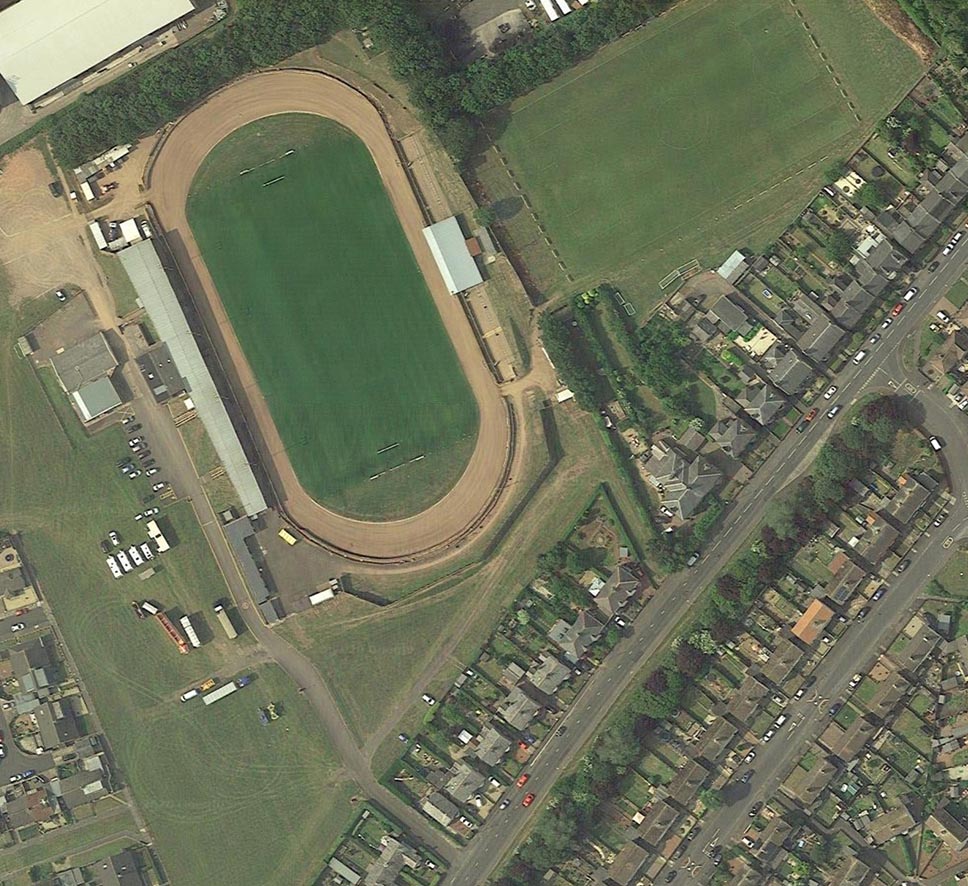
Hover image to enlarge

Google Earth aerial view of Shielfield Park and surrounding area.

Hover image to enlarge

An aerial view of Shielfield Park.
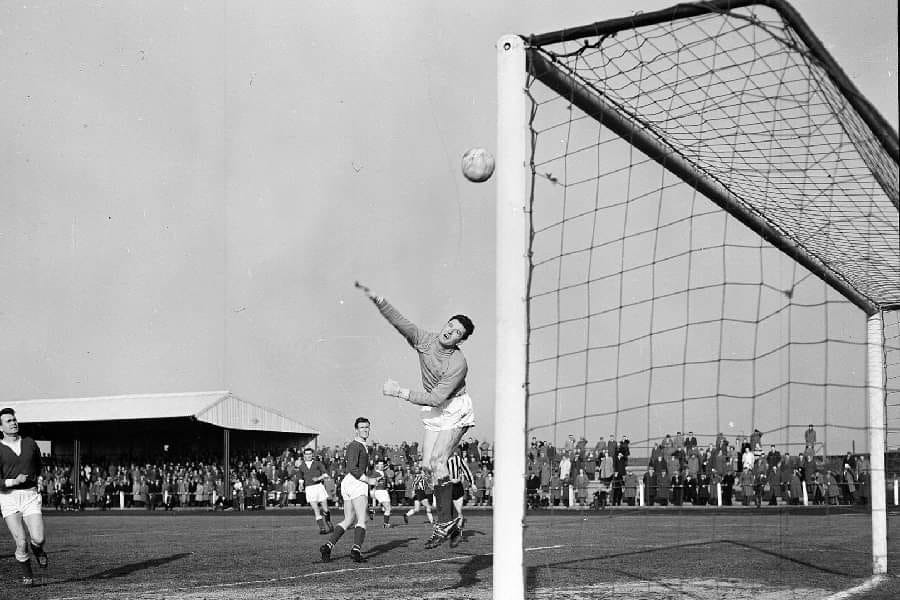
Hover image to enlarge

Match action at Shielfield Park.
23rd February 1963, Scottish League Division 2, Berwick Rangers 4-0 Stenhousemuir. Attendance 766
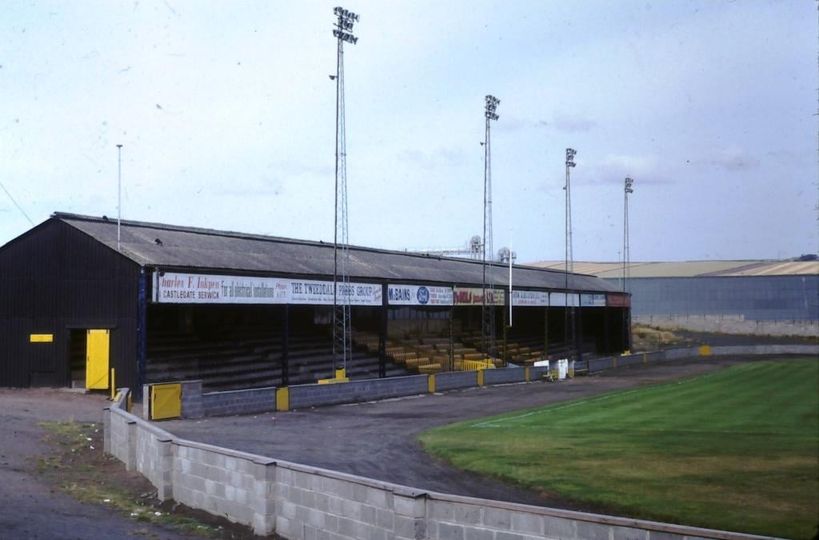
Hover image to enlarge

The old main stand at Shielfield Park.